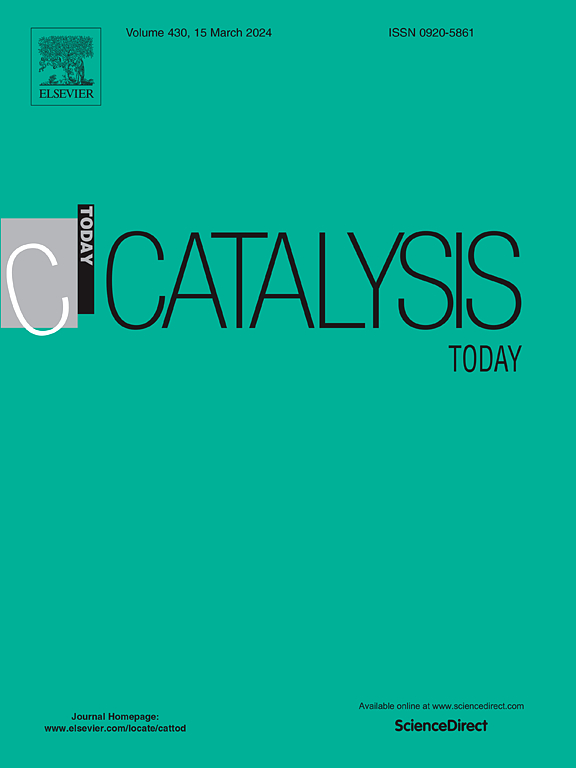微乳液中萜烯的放大环氧化反应
IF 5.2
2区 化学
Q1 CHEMISTRY, APPLIED
引用次数: 0
摘要
二氧环烷环氧化传统上是在两相介质中进行的:一种是稀释待环氧化烯烃的有机溶剂,另一种是溶解过氧单硫酸盐氧化剂的水相介质。这种相不相容一般需要大量的氧化剂,产氧量不超过25% %。尽管这项技术有很大的优势,但它仍然只在实验室规模上使用。本研究的目的是说明二氧环环氧化能力在数百毫升的规模生产萜烯环氧化物。该技术采用丙酮催化剂,与氧酮®反应生成二甲基二氧环,使萜烯环氧化。Oxone®是一种水性氧化剂。为了弥补其与疏水性萜烯的不相容性,使用高于临界胶束浓度(cmc)的表面活性剂,使萜烯在没有任何额外有机溶剂的情况下,通过形成微乳液在水介质中高度分散,从而提高了界面反应速率,减少了氧损失。在25℃和90 min条件下,几百毫升的柠檬烯、α-蒎烯、β-蒎烯、α-萜烯、γ-萜烯、β-月桂烯和法尼烯很容易被环氧化,转化率和选择性均接近100% %。氧收率高达80 %,而无微乳时为29 %。环氧化物的高选择性、无溶剂的水溶液反应、环境条件、简单的丙酮作为催化剂以及环氧化物易于从水介质中分离,使该创新工艺更适合于规模化生产。本文章由计算机程序翻译,如有差异,请以英文原文为准。
Scaled up epoxidation of terpenes in microemulsion
The dioxirane epoxidation was traditionally carried out in a two-phase medium: an organic solvent to dilute the olefin to be epoxidised and an aqueous medium in which the peroxymonosulphate oxidant is dissolved. This phase incompatibility generally requires a large quantity of oxidant and oxygen yield does not exceed 25 %. Despite the major advantages of this technique, it is still only used at laboratory scale. The aim of this study is to illustrate a dioxirane epoxidation ability to produce terpene epoxides at the scale of hundreds of milliliters. The technique employs an acetone catalyst that reacts with oxone® to in-situ form dimethyldioxirane, which epoxidizes the terpene. Oxone® is an aqueous oxidant. To remedy its incompatibility with hydrophobic terpene the use of a surfactant at concentration above its critical micelle concentration (cmc) enabled the terpene to be highly dispersed in the aqueous medium in absence of any additional organic solvent by forming a microemulsion, thus improving interface reaction rate and reducing oxygen loss. At 25°C and for a tr of 90 min, several hundred milliliters of limonene, α-pinene, β-pinene, α-terpinene, γ-terpinene, β-myrcene and farnesene were easily epoxidized with both conversion and selectivity of almost 100 %. Oxygen yields of up to 80 % were achieved, against 29 % in absence of microemulsion. The high selectivity of epoxides, the solvent-free aqueous reaction, the ambient conditions, the simple acetone used as catalyst and the easy separation of epoxides from the aqueous medium make this innovative process more appropriate for easy scale-up.
求助全文
通过发布文献求助,成功后即可免费获取论文全文。
去求助
来源期刊

Catalysis Today
化学-工程:化工
CiteScore
11.50
自引率
3.80%
发文量
573
审稿时长
2.9 months
期刊介绍:
Catalysis Today focuses on the rapid publication of original invited papers devoted to currently important topics in catalysis and related subjects. The journal only publishes special issues (Proposing a Catalysis Today Special Issue), each of which is supervised by Guest Editors who recruit individual papers and oversee the peer review process. Catalysis Today offers researchers in the field of catalysis in-depth overviews of topical issues.
Both fundamental and applied aspects of catalysis are covered. Subjects such as catalysis of immobilized organometallic and biocatalytic systems are welcome. Subjects related to catalysis such as experimental techniques, adsorption, process technology, synthesis, in situ characterization, computational, theoretical modeling, imaging and others are included if there is a clear relationship to catalysis.
 求助内容:
求助内容: 应助结果提醒方式:
应助结果提醒方式:


